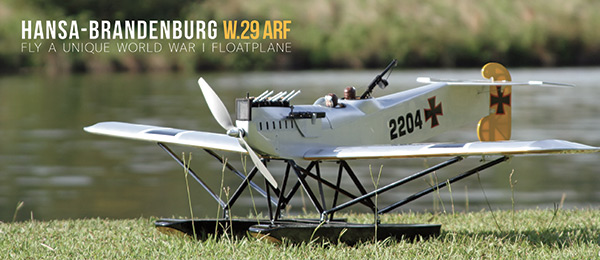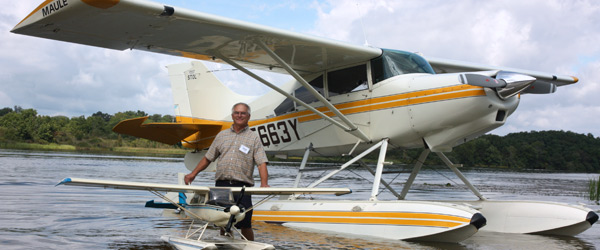Hansa-Brandenburg W.29

Written by Greg Gimlick As featured on page 60 in the February 2013 issue of Model Aviation. As featured in the Model Aviation tablet app. SPECIFICATIONS Model Type: Semi-scale ARF Skill level: Intermediate builder/pilot Wingspan: 53 inches Wing Area: 530 square inches Airfoil: Semi-symmetrical Length: 43 inches Weight: Two pounds, 8 ounces Power system: 600 size electric motor, 3S Lipo, 45a ESC Radio: Four-channel and 4 micro servos Construction: Built up wood Covering: Iron on film Street Price: $ 219.00 Test-Model Details Power system: E-flite Power 15, Castle Creations ICE Lite 50 ESC Battery: Zeus 3S 11.1v 2200mah lipo Propeller: APC 12x10E Radio system: JR 9503 transmitter, Spektrum AR6210 DSMX receiver, four Hitec HS-65HB servos, Ready-to-fly weight: 3 pounds 14 ounces Flight duration: 8 minutes Pluses: • Unique design • Excellent covering and construction • Easily removable cockpit held by magnets and dowels • Scale accessory package • Pre-drilled control horn holes • Online updates for manual • Flight performance Minuses: • Wing joiner tube was loose in wing • Screws to attach wing strut to wing are very small • Difficult to access motor battery Wow! That was my first impression when I opened the box and worked my way through all of the protective wrap and tape. The model arrived double boxed and well prepared for its trek across the country. The covering was well done with no wrinkles and the airplane’s design was enough to get me excited about starting the build. I’ll confess to temporarily slapping the wings and tail on so I could admire it and make airplane noises. My wife is used to this by now. This is a semiscale model of a World War I German warbird. I’ve had trouble convincing a couple of people of this, but it’s true. The airplane was innovative for its time. The vertical fin/rudder was designed to give the gunner great visibility and field of fire to the rear without having to worry about shooting his airplane’s tail off. With a top speed of 110 mph, excellent power, and maneuverability, the W.29 likely proved to be the best seaplane of the war. A W.29 actually attacked and disabled a submarine encountered running on the surface in the North Sea. Both the full-scale airplane and the model can be outfitted with skis for year-round operations. Read the full review in the tablet app and on page 60 of the February 2013 issue of Model Aviation magazine.
Similar Articles
 | The Grumman Goose
Designed by Paul Kohlmann.Watch flight videos, read excerpt from the article, and order plans. |
 | Midwest Regional Float Fly
Written by Jay Smith. As featured on page 20 in the May 2012 issue. Read the excerpts and online exclusive content. |
| The Icon A5
Written by Jay Smith. Find the full feature on page 55 in the May 2012 issue.Watch a shop video and an interview with the designer. |










Add new comment